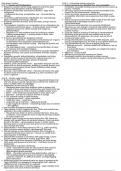Geo paper 3 notes: Unit 9 – Consuming energy resources
Unit 7 – People and the Biosphere Energy resources are classified into: non-renewable,
Biosphere contains all the living organisms and is the layer renewable, recyclable (energy sources that can be reuses e.g.
between the lithosphere and the atmosphere nuclear + biofuel)
Biosphere divided into nine biomes. Biomes = large-scale All energy products (renewable and non-renewable) have
ecosystems impacts on the environment / landscape
→ influenced by temp, precipitation, sun – all controlled by Access to energy resources depends on technology and
latitude accessibility. Coal often more expensive that other energy
Local factors affecting biome distribution are: rock/soil type, sources
water availability and orange, altitude Global energy increased since 2000 mostly driven by rapid
Biosphere provides humans: food and water, energy sources, development of emerging countries such as
materials China/India/Brazil
The biosphere maintains our composition of our atmosphere by: Oil reserves and production are unevenly distributed
o Maintains greenhouse gases – to keep planet warm enough Oil prices can vary owing to economic and political reasons –
o Regulates amount of carbon dioxide and oxygen by OPEC members restricting supplies to keep prices high and
photosynthesis conflict reasons.
o Regulates CO2 and methane levels by locking up carbon Using tar sands to produce oil and gas is unconventional
(carbon sequestration) → storing carbon in trees, soils, Extracting shale gas and oil only possible due to tech
permafrost, rocks etc. advancements. Its expensive, env issues such as lots of
3 services provided by the biosphere include: energy and water used.
o Atmosphere radiation – production and maintenance of gases Energy diversification including use of HEP, biofuels, solar
in atmosphere for respiration, photosynthesis etc. energy and hydrogen tech are ways to meet global demands
o Soil formation and nutrient cycling – allowing for growth and Two possibilities for the future of global energy use:
reproduction o Business as usual – assumes world will continue to rely on
o The hydrological cycle – movement and purification of water fossil fuels
for humans and sanitation/hygiene o A sustainable future – renewables are adopted to reduce
Nutrient cycling = movement of nutrients around the biosphere CO2 emissions
between biomass (soil, plants and animals) and litter (organic Affluence = rising wealth
matter) Affluence places greater pressure on planet
Population growth, industrialisation, urbanisation and rising Developed countries hve started to reduce energy
wealth ;led to increase in demand for natural resources → consumption per capita b using technology (e.g. LED bulbs)
biomes destroyed for farming, species threatened,
rivers/atmosphere polluted
Malthus’ view (pessimistic view) – population will grow and the
planet will run out of resources, leading to ‘positive checks’ (war,
famine) or preventative checks (fewer children) which would
decrease population
Boserup’s view (optimistic view) – Humans will invent new ways
to allow more resources to supplied (e.g. farm machinery, GM
crops, irrigation)
Unit 8 – Forests under threat
Biodiversity in TRFs are high because: of equatorial climate (hot
and wet all year around), species have evolved over millions of
years, multiple layers of vegetation
Adaptations to the climate of TRFs:
o Hardwood trees have large buttress roots to support the
weight of trees and leaves and branches only found at the top
o Lianas – use tree to climb to top for sunlight (woody vines)
o Birds – some birds have strong beaks to crack open nuts
o Primates – use tails for balance and live in canopy
In TRF, nutrient cycling is rapid because:
o Large biomass store – dense vegetation
o Small litter store – rapid decay
o Large take-up of nutrients – rapid plant growth
o Larger supply of nutrients – weathering; larger loss of nutrient
– throughflow
→ can be easily disrupted by deforestation
Taiga climate is harsh, biodiversity low. Plants and animals have
adapted to the cold conditions to survive:
o Mammals have thick fur, Some animals hibernate, trees are
coniferous, cone shaped for snow to slip off and waxy needles
to reduce water loss
Nutrient cycle in taiga occurs more slowly than TRF. Stores are
smaller with smaller flows of nutrients between. Most nutrients
found in the litter – decay happens slower in colder temps.
Biomass store is small as trees only grow for few months of the
year. Rainfall also lower
Deforestation is main direct threat to TRF. E.g. cattle ranching,
debt (countries export timber), development, Demand
Climate change is main indirect threat to TRFs. Droughts in
Amazon becoming more common → forest can switch from
absorbing CO2 to emitting it
Deforestation greatest in countries with taiga forests. Causes
include: paper, construction, mining, fossil fuels, HEP
Taiga under threat from increase in wildfires (as Arctic temps
rise), pests and diseases and acid rain – contribute to loss of
biodiversity
Global actions to protect rainforests:
o CITES - international treaty by 180 countries that protects
species. However protecting species doesn’t prevent
deforestation/global warming
o REDD – UN project aiming to stop deforestation with gov +
TNCs funding projects to conserve forests in developing
countries. However, it’s difficult to police so illegal logging
often takes place
Wilderness areas and national parks are ways of protecting the
Taiga. RAMSAR is an example of conservation that’s adds an
additional level of protection for wetlands
Sustainable alternative is selective logging – large valuable trees
taken down and some of forest still intact.




